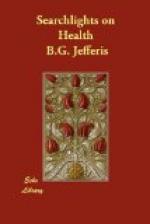7. When the pains become regular and intermit, it is time that the physician is sent for. On the physician’s arrival he will always take charge of the case and give necessary instructions.
8. In nearly all cases the head of the child is presented first. The first pains are generally grinding and irregular, and felt mostly in the groins and within, but as labor progresses the pains are felt in the abdomen, and as the head advances there is severe pain in the back and hips and a disposition to bear down, but no pressure should be placed upon the abdomen of the patient; it is often the cause of serious accidents. Nature will take care of itself.
9. Conversation should be of a cheerful character, and all allusions to accidents of other child births should be carefully avoided.
10. ABSENCE OF PHYSICIAN.—In case the child should be born in the absence of the physician, when the head is born receive it in the hand and support it until the shoulders have been expelled, and steady the whole body until the child is born. Support the child with both hands and lay it as far from the mother as possible without stretching the cord. Remove the mucus from the nostrils and mouth, wrap the babe in warm flannel, make the mother comfortable, give her a drink, and allow the child to remain until the pulsations in the cord have entirely ceased. After the pulsations have entirely ceased then sever the cord. Use a dull pair of scissors, cutting it about two inches from the child’s navel, and generally no time is necessary, and when the physician comes he will give it prompt attention.
11. If the child does not breathe at its arrival, says Dr. Stockham in her celebrated Tokology, a little slapping on the breast and body will often produce respiration, and if this is not efficient, dash cold water on the face and chest; if this fails then close the nostrils with two fingers, breathe into the mouth and then expel the air from the lungs by gentle pressure upon the chest. Continue this as long as any hope of life remains.
12. AFTER-BIRTH.—Usually contractions occur and the after-birth is readily expelled; if not, clothes wrung out in hot water laid upon the bowels will often cause the contraction of the uterus, and the expulsion of the after-birth.
13. If the cord bleeds severely inject cold water into it. This in many cases removes the after-birth.
14. After the birth of the child give the patient a bath, if the patient is not too exhausted, change the soiled quilts and clothing, fix up everything neat and clean and let the patient rest.
15 Let the patient drink weak tea, gruel, cold or hot water, whichever she chooses.




